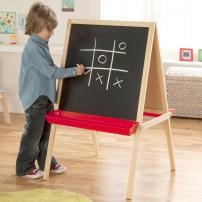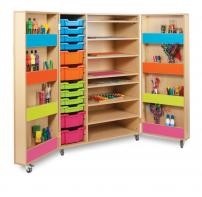Creative play encompasses a range of different activities that just about all children love participating in, from drawing and painting to building with Lego and dressing up. Anything that requires some creativity is creative play!
It is important for children to take part in creative activities as there are a range of benefits to developing a creative mind. Developing a love of creativity at a young age will help your child become a creative thinker as they grow older.
Intellectual and Cognitive Benefits
Creative activities, both alone and in a group situations, are beneficial to improving intellectual and cognitive skills in children, especially skills such as problem solving, imagination and critical thinking. Children should be allowed to experiment with creative activities, allowing them to explore different options and develop solutions on their own.
Reading is a fantastic creative activity for improving intellectual and cognitive skills as children can let their imaginations run wild and discover a world outside of their own. They can even combine this experience with art by drawing/painting the adventures that occur in the books they read.
Creative activities can also help to develop basic maths and science skills that help with problem solving and concentration. Learning this skills early will help your child transfer them to other areas of their life which will benefit them as they grow older.
Children love to ask ‘Why?’ – Creative activities, such as drama and miming will help them to think for themselves more and work out answers for themselves.
Emotional Benefits
Creativity and creative play are known to provide a positive outlet to express emotions, not just for children but for adults too! Make sure your children have access to creative equipment and materials as often as possible so they can always express themselves.
A good way to make sure your child always has access to creative equipment is to make a creative box for their room – included in the box should be: crayons, paints, paintbrushes, coloured pencils and pens, stamps, paper and card, and an apron to keep clean. There are a range of other items that would be great for a creative box, these are just the basics.
Social development
For children, creativity can be a social act, and help them to make new friends and strengthen bonds with existing friends. Singing, dancing and acting can all be group activities that are considered creative.
This group work helps children to understand social rules such as co-operation and sharing. Art and crafts group work can provide a safe way for children to socialise with others whilst learning and developing.
Physical Development
As well as intellectual, emotional and social benefits – creative play also has significant benefits to children’s physical well-being. Creative activities such as drawing, cutting, painting and building all help to develop fine motor skills. Developing these motor skills early is essential as it prepares them for writing as they get older.
Hand-eye coordination is also developed through creative play which can help in all sorts of situations in later life, such as when they start sports at school.
Encouraging Children to Participate in Creative Play
As creative play is so important in children’s development, you should encourage them to participate in these activities as much as possible. Participation on a regular basis will help to make a child’s naturally creative side appear.
Encouraging younger children to part in creative activities can be a difficult task, here are a few of our suggestions to get them involved:
- Get involved yourself – one of the best ways to get children involved in any play activities is to be a role model and participate yourself.
- Create a dedicated creative play area. This will give children the opportunity to take part in unstructured creative activities.
- To encourage creative activities, children’s screen time should be limited. This includes TV, computers, phones and video games. The American Academy of Paediatrics recommends no more than 1 to 2 hours of total screen time per day. Some screen time can be good though, so don’t cut it out completely!
The environment that the children are in also has a big impact on the way that they feel. For example, if they are in a dull and dark room with little colour they are less likely to be inspired to be creative. For children to be creative it is beneficial for them to be located in a comfortable, colourful room.
Early Learning Furniture Creative Equipment
We offer a range of creative play equipment that are ideal for use in homes, schools and pre-schools. The Two Sided Easel and Four Sided Easel are ideal products for getting children to work in groups to create artwork. The easels feature chalkboard and whiteboard sides – perfect for giving children a choice.

The Children’s Folding Table Top Theatre is a great creative role playing product for schools and nurseries with limited space as it can be folded down after use of easy storage and transportation. Children can hold shows for their peers using puppets and toys.
The art storage cupboard is a handy school storage cabinet for all art supplies. The cupboard has 8 shelves in total, 4 on each door as well as 4 deep trays and 8 shallow trays. 1 fixed shelf and 6 adjustable shelves are also included which are ideal for paper storage or for drying artwork once completed.

At Early Learning Furniture we provide an extensive range of classroom furniture designed for primary schools, pre-schools and nurseries. Our early years’ furniture includes classroom tablesand chairs, school classroom storage and classroom trays.
All of our furniture for schools is made in the UK and we offer free delivery on all of our products.
Permalink:
https://www.earlylearningfurniture.co.uk/blog/benefits-of-creative-play-in-early-education.aspx